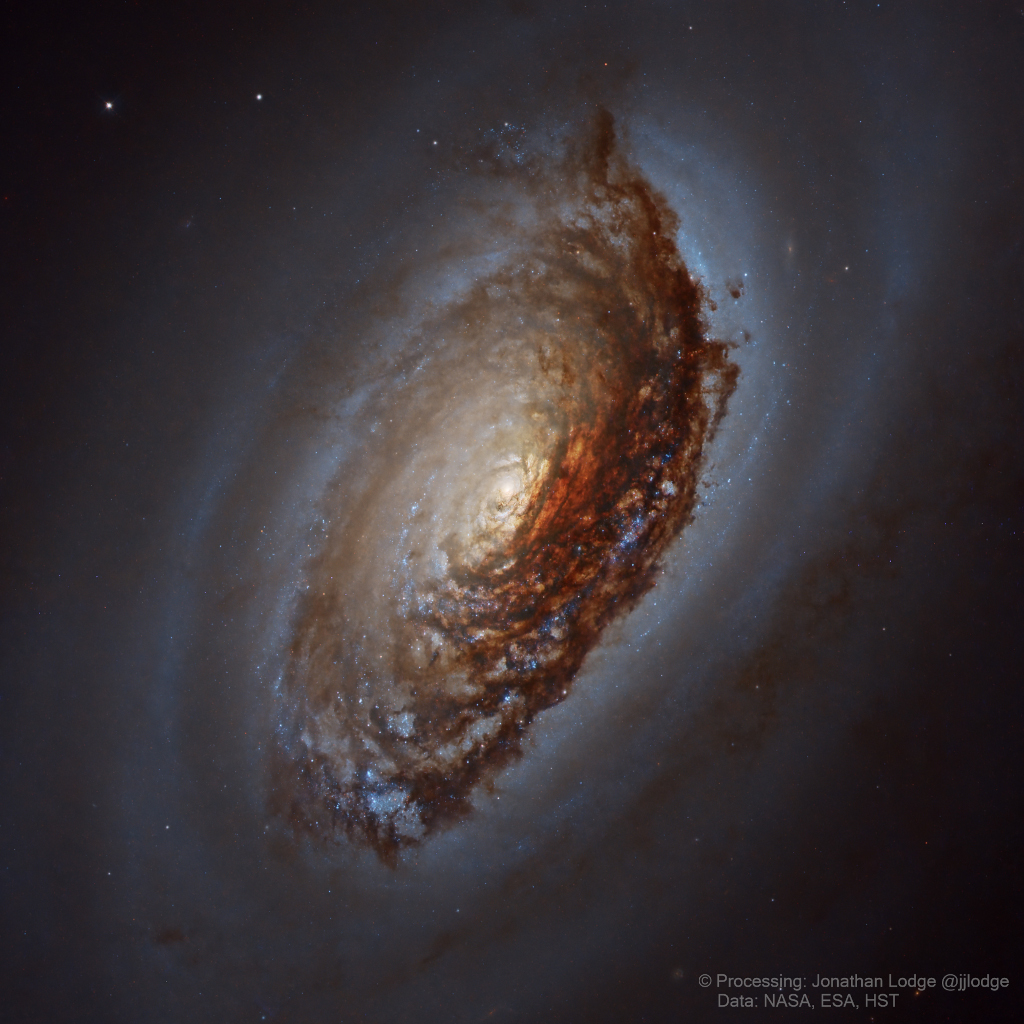20. July 2023
M64:烏目睭星系 ê 特寫

探索宇宙1!逐工會揀一幅無仝款 ê 影像抑是相片,𤆬你熟似咱這个迷人 ê 宇宙,閣有專業天文學者2為你3解說4。
- 原始文章:M64: The Black Eye Galaxy Close Up
- 影像來源:NASA, ESA, Hubble, HLA; 資料處理:Jonathan Lodge
- 台文翻譯:An-Li Tsai (NCU)
[漢羅] M64:烏目睭星系 ê 特寫
這个壯麗 ê 捲螺仔星系是 Messier 64,伊定定去 hŏng 叫做 烏目睭星系,抑是叫做 睏美人星系,因為伊 tī 望遠鏡內底看起來有 烏烏 ê 目睭皮。 這張是 Hubble 太空望遠鏡翕 ê 影像,伊翕著 ê 捲螺仔星系中心區,差不多有 7400 光年闊。 M64 就 tī 北天星座 后鬃座 方向 1700 萬光年遠 ê 所在。 這寡量足大 ê 塗粉雲,kā M64 中央區 閘著一部份,kah 少年 ê 藍光星團、恆星形成區發紅光 ê 水素 濫濫做伙。 毋過壯觀 ê 塗粉雲 毋是 這个星系 唯一特別 ê 部份。 觀測結果 kā 咱講,M64 實際上是兩个仝圓心、倒剾踅 ê 系統。 M64 內底所有 ê 恆星攏 kah 星系中心區 ê 星際氣體踅仝一个方向。 毋過中心區外口 一直到 4 萬光年遠 ê 氣體,煞 踅 無仝方向。 伊有 塗粉箍出來 ê 目睭 kah 奇怪 ê 轉踅,這可能是兩个星系 tī 幾若十億年前合併 ê 結果。
[POJ] M64: O͘-ba̍k-chiu seng-hē ê Te̍k-siá
Chit-ê chòng-lē ê kńg-lê-á seng-hē sī Messier 64, i tiāⁿ-tiāⁿ khì hőng kiò-chò O͘-ba̍k-chiu seng-hē, ia̍h-sī kiò-chò Khùn-bí-jîn seng-hē, in-ūi i tī bōng-oán-kiàⁿ lāi-té khòaⁿ--khí-lâi ū o͘-o͘ ê ba̍k-chiu-phôe. Chit-tiuⁿ sī Hubble thài-khong bōng-oán-kiàⁿ hip ê iáⁿ-siōng, i hip-tio̍h ê kńg-lê-á seng-hē tiong-sim-khu, chha-put-to ū 7400 kng-nî khoah. M64 tō tī pak-thian seng-chō Hiō-chang-chō hong-hiòng 1700 bān kng-nî hn̄g ê só͘-chāi. Chit-kóa liōng chiok tōa ê thô͘-hún hûn, kā M64 tiong-ng-khu cha̍h-tio̍h chi̍t-pō͘-hūn, kah siàu-liân ê nâ-kng seng-thoân, hêng-chheⁿ hêng-sêng-khu hoat âng-kng ê chúi-sò͘ lām-lām chò-hóe. M̄-koh chòng-koan ê thô͘-hún-hûn m̄-sī chit-ê seng-hē ûi-it te̍k-pa̍t ê pō͘-hūn. Koan-chhek kiat-kó kā lán kóng, M64 si̍t-chè-siōng sī nn̄g-ê kāng-îⁿ-sim, tò-khau-se̍h ê hē-thóng. M64 lāi-té só͘-ū ê hêng-chheⁿ lóng kah seng-hē tiong-sim-khu ê seng-chè khì-thé se̍h kāng chi̍t-ê hong-hiòng. M̄-koh tiong-sim-khu gōa-kháu it-ti̍t kàu 4 bān kng-nî hn̄g ê khì-thé, soah se̍h bô-kâng hong-hiòng. I ū thô͘-hún kho͘ chhut-lâi ê ba̍k-chiu kah kî-koài ê tńg-se̍h, che khó-lêng sī nn̄g-ê seng-hē tī kúi-nā cha̍p-ek nî-chêng ha̍p-pèng ê kiat-kó.
[KIP] M64: Oo-ba̍k-tsiu sing-hē ê Ti̍k-siá
Tsit-ê tsòng-lē ê kńg-lê-á sing-hē sī Messier 64, i tiānn-tiānn khì hőng kiò-tsò Oo-ba̍k-tsiu sing-hē, ia̍h-sī kiò-tsò Khùn-bí-jîn sing-hē, in-uī i tī bōng-uán-kiànn lāi-té khuànn--khí-lâi ū oo-oo ê ba̍k-tsiu-phuê. Tsit-tiunn sī Hubble thài-khong bōng-uán-kiànn hip ê iánn-siōng, i hip-tio̍h ê kńg-lê-á sing-hē tiong-sim-khu, tsha-put-to ū 7400 kng-nî khuah. M64 tō tī pak-thian sing-tsō Hiō-tsang-tsō hong-hiòng 1700 bān kng-nî hn̄g ê sóo-tsāi. Tsit-kuá liōng tsiok tuā ê thôo-hún hûn, kā M64 tiong-ng-khu tsa̍h-tio̍h tsi̍t-pōo-hūn, kah siàu-liân ê nâ-kng sing-thuân, hîng-tshenn hîng-sîng-khu huat âng-kng ê tsuí-sòo lām-lām tsò-hué. M̄-koh tsòng-kuan ê thôo-hún-hûn m̄-sī tsit-ê sing-hē uî-it ti̍k-pa̍t ê pōo-hūn. Kuan-tshik kiat-kó kā lán kóng, M64 si̍t-tsè-siōng sī nn̄g-ê kāng-înn-sim, tò-khau-se̍h ê hē-thóng. M64 lāi-té sóo-ū ê hîng-tshenn lóng kah sing-hē tiong-sim-khu ê sing-tsè khì-thé se̍h kāng tsi̍t-ê hong-hiòng. M̄-koh tiong-sim-khu guā-kháu it-ti̍t kàu 4 bān kng-nî hn̄g ê khì-thé, suah se̍h bô-kâng hong-hiòng. I ū thôo-hún khoo tshut-lâi ê ba̍k-tsiu kah kî-kuài ê tńg-se̍h, tse khó-lîng sī nn̄g-ê sing-hē tī kuí-nā tsa̍p-ik nî-tsîng ha̍p-pìng ê kiat-kó.
[English] M64: The Black Eye Galaxy Close Up
This magnificent spiral galaxy is Messier 64, often called the Black Eye Galaxy or the Sleeping Beauty Galaxy for its dark-lidded appearance in telescopic views. The spiral's central region, about 7,400 light-years across, is pictured in this reprocessed image from the Hubble Space Telescope. M64 lies some 17 million light-years distant in the otherwise well-groomed northern constellation Coma Berenices. The enormous dust clouds partially obscuring M64's central region are laced with young, blue star clusters and the reddish glow of hydrogen associated with star forming regions. But imposing clouds of dust are not this galaxy's only peculiar feature. Observations show that M64 is actually composed of two concentric, counter-rotating systems. While all the stars in M64 rotate in the same direction as the interstellar gas in the galaxy's central region, gas in the outer regions, extending to about 40,000 light-years, rotates in the opposite direction. The dusty eye and bizarre rotation are likely the result of a billion year old merger of two different galaxies.
詞彙學習
| 漢羅 | POJ | KIP | 華語 | English |
|---|---|---|---|---|
| 捲螺仔星系 | kńg-lê-á seng-hē | kńg-lê-á sing-hē | 螺旋星系 | spiral galaxy |
| 烏目睭星系 | O͘-ba̍k-chiu seng-hē | Oo-ba̍k-tsiu sing-hē | 黑眼星系 | Black Eye Galaxy |
| 睏美人星系 | Khùn-bí-jîn seng-hē | Khùn-bí-jîn sing-hē | 睡美人 | Sleeping Beauty Galaxy |
| 仝圓心 | kāng-īⁿ-sim | kāng-īnn-sim | 同心 | concentric |
| 倒剾踅 | tò-khau-se̍h | tò-khau-se̍h | 逆時針轉 | counter-rotating |
| 目睭皮 | ba̍k-chiu-phôe | ba̍k-tsiu-phuê | 眼瞼 | eyelids |
| 后鬃座 | Hiō-chang-chō | Hiō-tsang-tsō | 后鬃座 | Coma Berenices |
| 星團 | seng-thoân | sing-thuân | 星團 | star clusters |
| 恆星形成區 | hêng-chheⁿ hêng-sêng-khu | îng-tshenn hîng-sîng-khu | 恆星形成區 | star foring region |
| 水素 | chúi-sò͘ | tsuí-sòo | 氫 | hydrogen |
| 星際氣體 | seng-chè-khì-thé | sing-tsè-khì-thé | 星際氣體 | interstellar gas |